Understanding Badges of Trade and Taxation in the UK
VerifiedAdded on 2023/06/04
|12
|2836
|487
AI Summary
This study explains the badges of trade and how they determine whether a transaction is a trading activity. It also discusses tax evasion vs tax avoidance, VAT registration, VAT liability, and bad debt relief in the UK. The study is helpful for anyone seeking expert guidance on taxation.
Contribute Materials
Your contribution can guide someone’s learning journey. Share your
documents today.
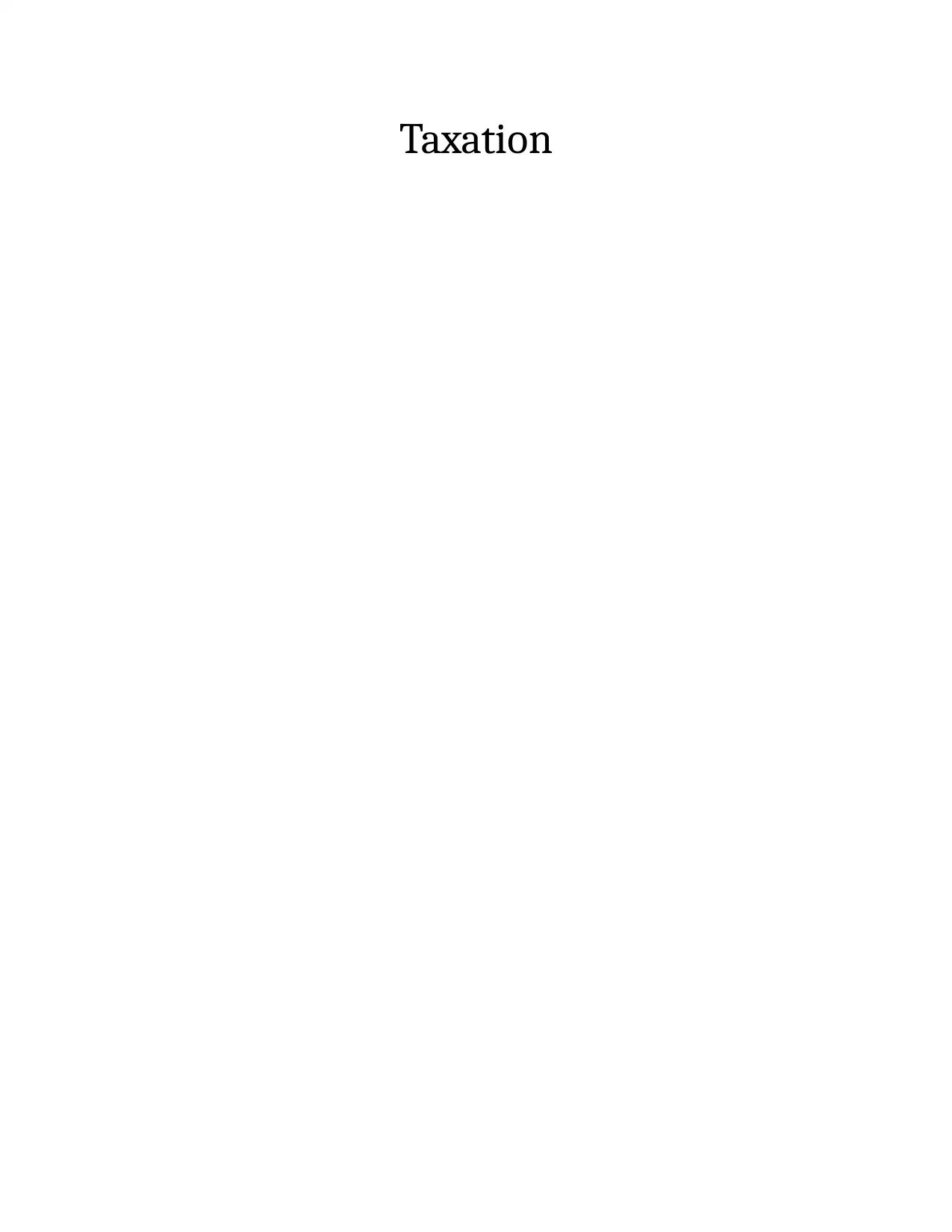
Taxation
Secure Best Marks with AI Grader
Need help grading? Try our AI Grader for instant feedback on your assignments.

TABLE OF CONTENTS
Introduction......................................................................................................................................3
Question 1........................................................................................................................................3
Question 2........................................................................................................................................5
(a).................................................................................................................................................5
(b).................................................................................................................................................6
Question 3........................................................................................................................................6
(a).................................................................................................................................................6
(b).................................................................................................................................................7
(c).................................................................................................................................................8
Question 4........................................................................................................................................9
(a).................................................................................................................................................9
(b).................................................................................................................................................9
(c).................................................................................................................................................9
(d)...............................................................................................................................................10
REFERENCES..............................................................................................................................11
Introduction......................................................................................................................................3
Question 1........................................................................................................................................3
Question 2........................................................................................................................................5
(a).................................................................................................................................................5
(b).................................................................................................................................................6
Question 3........................................................................................................................................6
(a).................................................................................................................................................6
(b).................................................................................................................................................7
(c).................................................................................................................................................8
Question 4........................................................................................................................................9
(a).................................................................................................................................................9
(b).................................................................................................................................................9
(c).................................................................................................................................................9
(d)...............................................................................................................................................10
REFERENCES..............................................................................................................................11
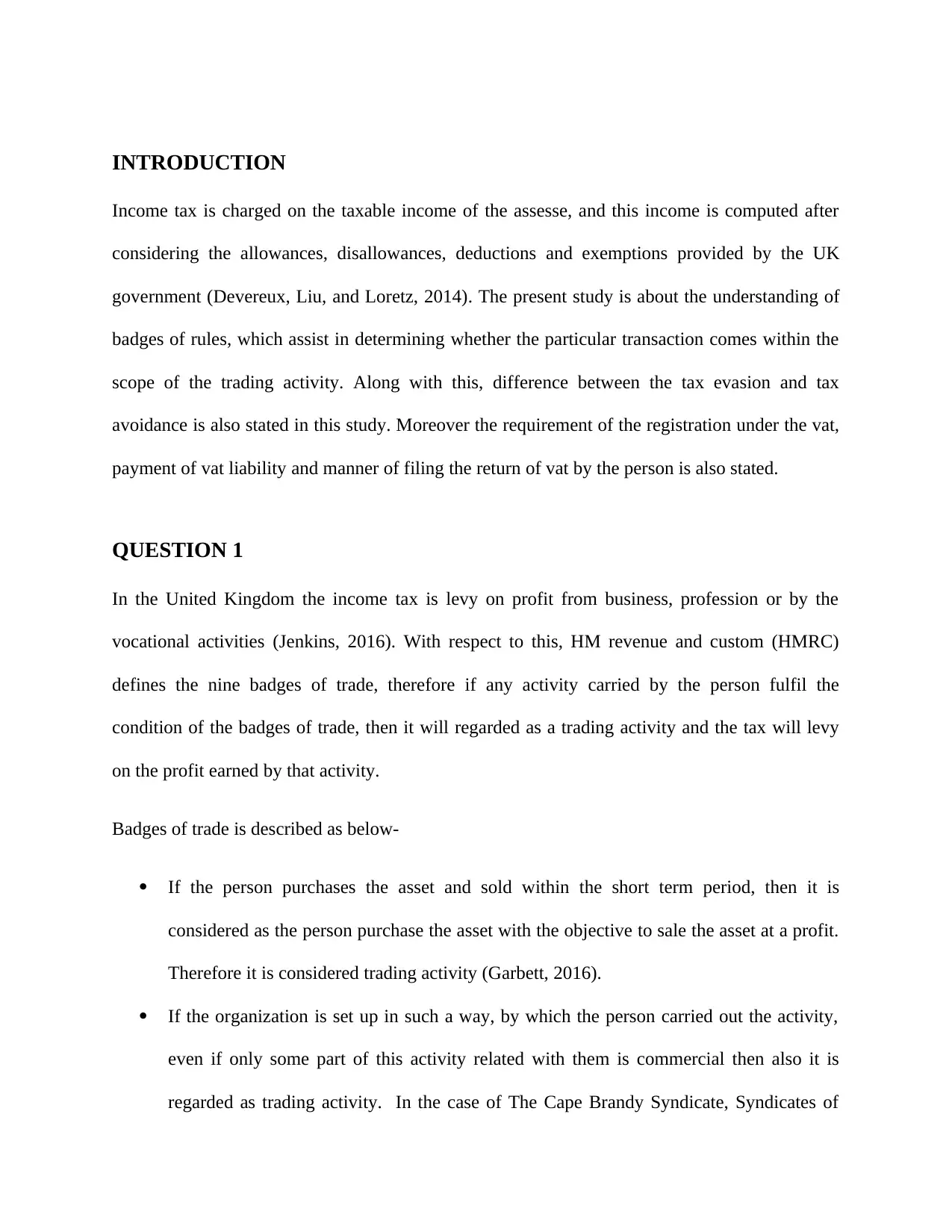
INTRODUCTION
Income tax is charged on the taxable income of the assesse, and this income is computed after
considering the allowances, disallowances, deductions and exemptions provided by the UK
government (Devereux, Liu, and Loretz, 2014). The present study is about the understanding of
badges of rules, which assist in determining whether the particular transaction comes within the
scope of the trading activity. Along with this, difference between the tax evasion and tax
avoidance is also stated in this study. Moreover the requirement of the registration under the vat,
payment of vat liability and manner of filing the return of vat by the person is also stated.
QUESTION 1
In the United Kingdom the income tax is levy on profit from business, profession or by the
vocational activities (Jenkins, 2016). With respect to this, HM revenue and custom (HMRC)
defines the nine badges of trade, therefore if any activity carried by the person fulfil the
condition of the badges of trade, then it will regarded as a trading activity and the tax will levy
on the profit earned by that activity.
Badges of trade is described as below-
If the person purchases the asset and sold within the short term period, then it is
considered as the person purchase the asset with the objective to sale the asset at a profit.
Therefore it is considered trading activity (Garbett, 2016).
If the organization is set up in such a way, by which the person carried out the activity,
even if only some part of this activity related with them is commercial then also it is
regarded as trading activity. In the case of The Cape Brandy Syndicate, Syndicates of
Income tax is charged on the taxable income of the assesse, and this income is computed after
considering the allowances, disallowances, deductions and exemptions provided by the UK
government (Devereux, Liu, and Loretz, 2014). The present study is about the understanding of
badges of rules, which assist in determining whether the particular transaction comes within the
scope of the trading activity. Along with this, difference between the tax evasion and tax
avoidance is also stated in this study. Moreover the requirement of the registration under the vat,
payment of vat liability and manner of filing the return of vat by the person is also stated.
QUESTION 1
In the United Kingdom the income tax is levy on profit from business, profession or by the
vocational activities (Jenkins, 2016). With respect to this, HM revenue and custom (HMRC)
defines the nine badges of trade, therefore if any activity carried by the person fulfil the
condition of the badges of trade, then it will regarded as a trading activity and the tax will levy
on the profit earned by that activity.
Badges of trade is described as below-
If the person purchases the asset and sold within the short term period, then it is
considered as the person purchase the asset with the objective to sale the asset at a profit.
Therefore it is considered trading activity (Garbett, 2016).
If the organization is set up in such a way, by which the person carried out the activity,
even if only some part of this activity related with them is commercial then also it is
regarded as trading activity. In the case of The Cape Brandy Syndicate, Syndicates of

chartered accountants refined brandy. Since the organization argues that they sold only
that much brandy which is left after their consumption. But the department argues that,
the organization had set up special phone line, carried the promotion activity and separate
information desk, therefore all the activities are considered under definition of trading
activity.
The purpose of the buying and selling the asset is also plays a very important role in
determining whether the transaction is considered as a trading activity or not (Garbett,
2016). Even if the asset is acquired as a gift or in inheritance, but the person who
acquired the asset, sell the asset by making the advertisement and earn the profit on them.
Then it is regarded as trading activity.
Any transaction undertaken by the person with the intention to making the profit from the
same is regarded as a trading activity. However existence of the profit does not make any
impact, if the objective or the intention is present then only it is the trading activity.
The nature of transaction carried out by the person is also evaluated for ascertaining the
trading activity. Even if the single transaction of the buying and selling activity leads to
the trading profit then also it will be covered under trading activity. In the case of
“Rutledge v CIR” the tax payer purchased one million rolls of toilet paper in one
transaction and also sold all the rolls in single transaction (Garbett, 2016). It is termed as
trading which is in the nature of adventure.
For promoting the sale, if the person purchased the asset and then made the changes in
the asset which result in endorsing and selling the asset. Then this activity is regarded as
a trading activity.
that much brandy which is left after their consumption. But the department argues that,
the organization had set up special phone line, carried the promotion activity and separate
information desk, therefore all the activities are considered under definition of trading
activity.
The purpose of the buying and selling the asset is also plays a very important role in
determining whether the transaction is considered as a trading activity or not (Garbett,
2016). Even if the asset is acquired as a gift or in inheritance, but the person who
acquired the asset, sell the asset by making the advertisement and earn the profit on them.
Then it is regarded as trading activity.
Any transaction undertaken by the person with the intention to making the profit from the
same is regarded as a trading activity. However existence of the profit does not make any
impact, if the objective or the intention is present then only it is the trading activity.
The nature of transaction carried out by the person is also evaluated for ascertaining the
trading activity. Even if the single transaction of the buying and selling activity leads to
the trading profit then also it will be covered under trading activity. In the case of
“Rutledge v CIR” the tax payer purchased one million rolls of toilet paper in one
transaction and also sold all the rolls in single transaction (Garbett, 2016). It is termed as
trading which is in the nature of adventure.
For promoting the sale, if the person purchased the asset and then made the changes in
the asset which result in endorsing and selling the asset. Then this activity is regarded as
a trading activity.
Secure Best Marks with AI Grader
Need help grading? Try our AI Grader for instant feedback on your assignments.
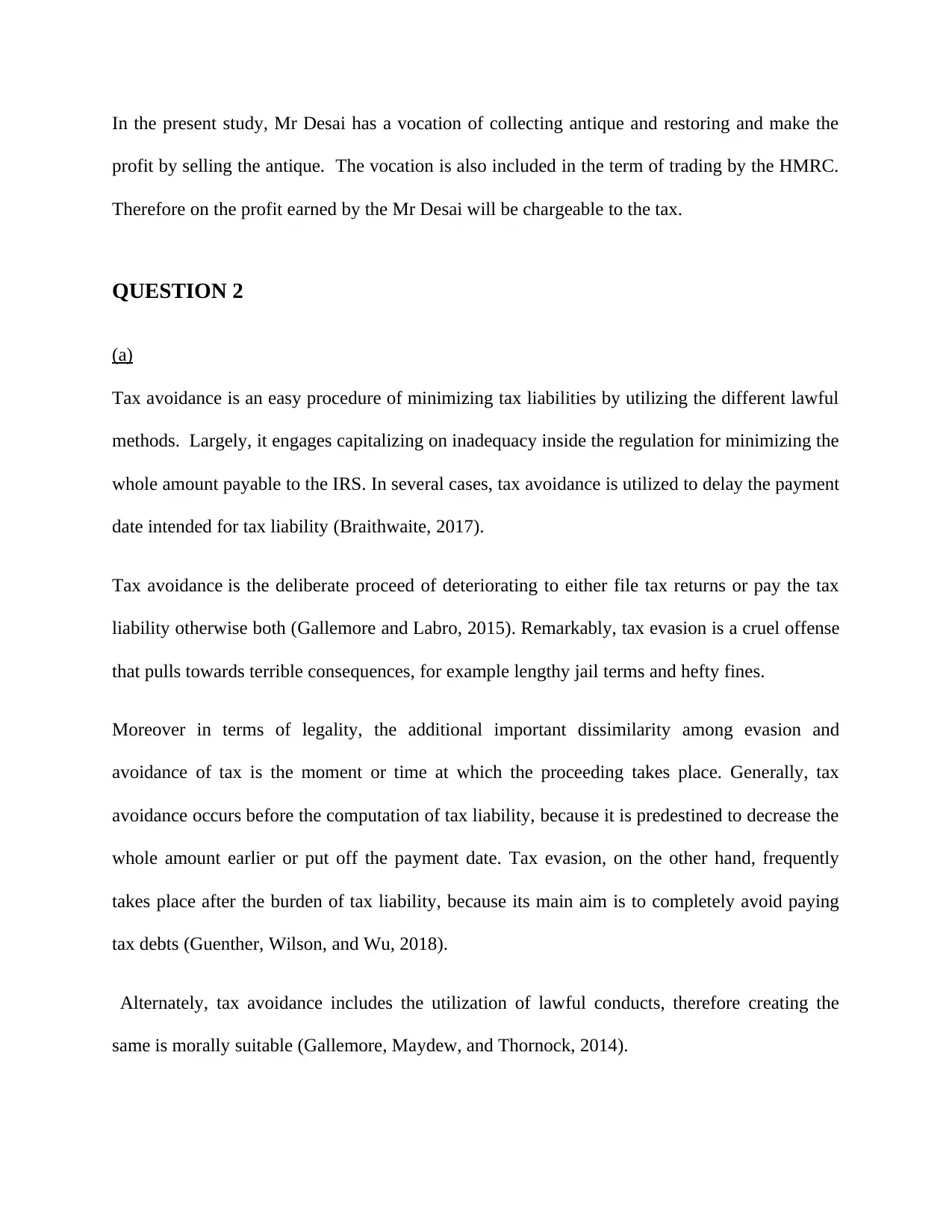
In the present study, Mr Desai has a vocation of collecting antique and restoring and make the
profit by selling the antique. The vocation is also included in the term of trading by the HMRC.
Therefore on the profit earned by the Mr Desai will be chargeable to the tax.
QUESTION 2
(a)
Tax avoidance is an easy procedure of minimizing tax liabilities by utilizing the different lawful
methods. Largely, it engages capitalizing on inadequacy inside the regulation for minimizing the
whole amount payable to the IRS. In several cases, tax avoidance is utilized to delay the payment
date intended for tax liability (Braithwaite, 2017).
Tax avoidance is the deliberate proceed of deteriorating to either file tax returns or pay the tax
liability otherwise both (Gallemore and Labro, 2015). Remarkably, tax evasion is a cruel offense
that pulls towards terrible consequences, for example lengthy jail terms and hefty fines.
Moreover in terms of legality, the additional important dissimilarity among evasion and
avoidance of tax is the moment or time at which the proceeding takes place. Generally, tax
avoidance occurs before the computation of tax liability, because it is predestined to decrease the
whole amount earlier or put off the payment date. Tax evasion, on the other hand, frequently
takes place after the burden of tax liability, because its main aim is to completely avoid paying
tax debts (Guenther, Wilson, and Wu, 2018).
Alternately, tax avoidance includes the utilization of lawful conducts, therefore creating the
same is morally suitable (Gallemore, Maydew, and Thornock, 2014).
profit by selling the antique. The vocation is also included in the term of trading by the HMRC.
Therefore on the profit earned by the Mr Desai will be chargeable to the tax.
QUESTION 2
(a)
Tax avoidance is an easy procedure of minimizing tax liabilities by utilizing the different lawful
methods. Largely, it engages capitalizing on inadequacy inside the regulation for minimizing the
whole amount payable to the IRS. In several cases, tax avoidance is utilized to delay the payment
date intended for tax liability (Braithwaite, 2017).
Tax avoidance is the deliberate proceed of deteriorating to either file tax returns or pay the tax
liability otherwise both (Gallemore and Labro, 2015). Remarkably, tax evasion is a cruel offense
that pulls towards terrible consequences, for example lengthy jail terms and hefty fines.
Moreover in terms of legality, the additional important dissimilarity among evasion and
avoidance of tax is the moment or time at which the proceeding takes place. Generally, tax
avoidance occurs before the computation of tax liability, because it is predestined to decrease the
whole amount earlier or put off the payment date. Tax evasion, on the other hand, frequently
takes place after the burden of tax liability, because its main aim is to completely avoid paying
tax debts (Guenther, Wilson, and Wu, 2018).
Alternately, tax avoidance includes the utilization of lawful conducts, therefore creating the
same is morally suitable (Gallemore, Maydew, and Thornock, 2014).
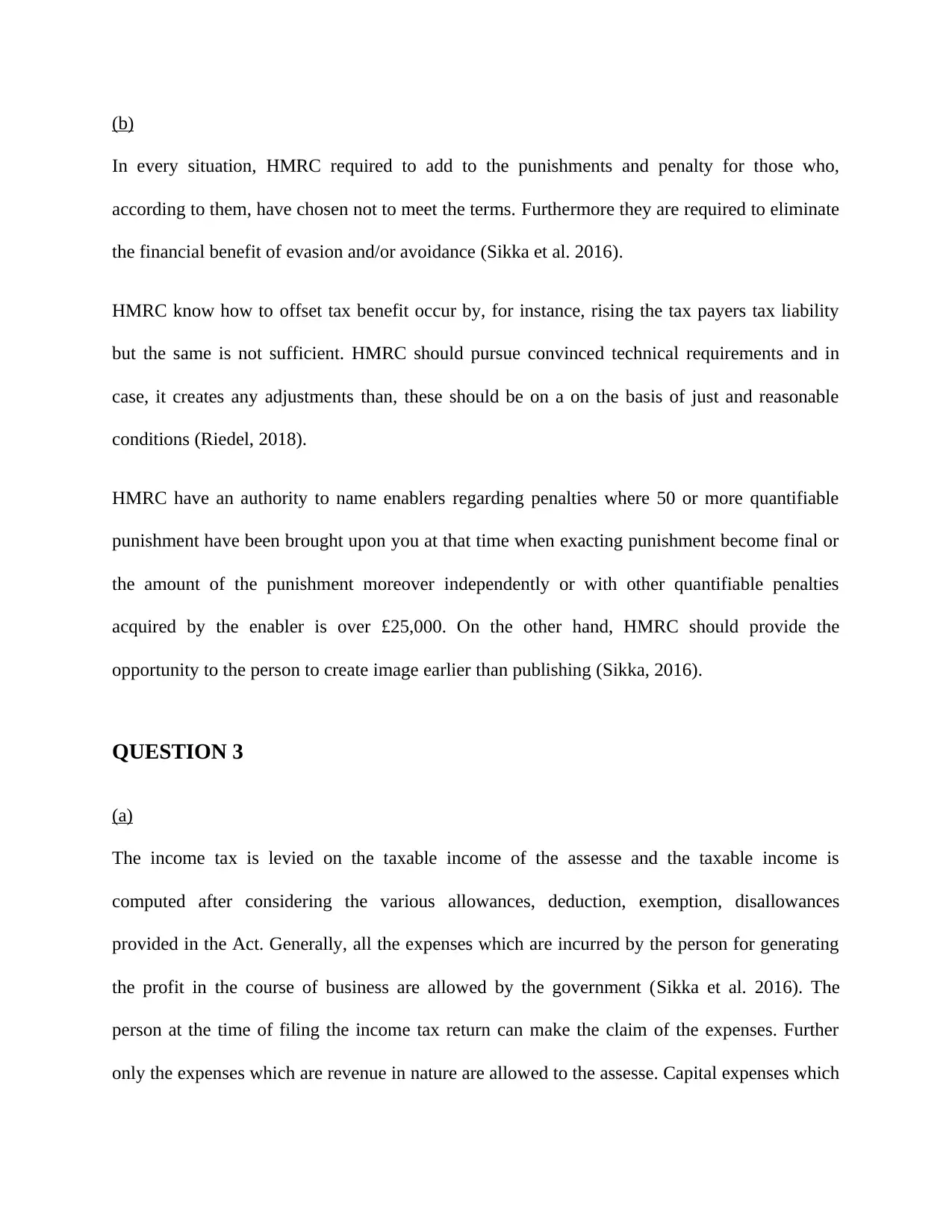
(b)
In every situation, HMRC required to add to the punishments and penalty for those who,
according to them, have chosen not to meet the terms. Furthermore they are required to eliminate
the financial benefit of evasion and/or avoidance (Sikka et al. 2016).
HMRC know how to offset tax benefit occur by, for instance, rising the tax payers tax liability
but the same is not sufficient. HMRC should pursue convinced technical requirements and in
case, it creates any adjustments than, these should be on a on the basis of just and reasonable
conditions (Riedel, 2018).
HMRC have an authority to name enablers regarding penalties where 50 or more quantifiable
punishment have been brought upon you at that time when exacting punishment become final or
the amount of the punishment moreover independently or with other quantifiable penalties
acquired by the enabler is over £25,000. On the other hand, HMRC should provide the
opportunity to the person to create image earlier than publishing (Sikka, 2016).
QUESTION 3
(a)
The income tax is levied on the taxable income of the assesse and the taxable income is
computed after considering the various allowances, deduction, exemption, disallowances
provided in the Act. Generally, all the expenses which are incurred by the person for generating
the profit in the course of business are allowed by the government (Sikka et al. 2016). The
person at the time of filing the income tax return can make the claim of the expenses. Further
only the expenses which are revenue in nature are allowed to the assesse. Capital expenses which
In every situation, HMRC required to add to the punishments and penalty for those who,
according to them, have chosen not to meet the terms. Furthermore they are required to eliminate
the financial benefit of evasion and/or avoidance (Sikka et al. 2016).
HMRC know how to offset tax benefit occur by, for instance, rising the tax payers tax liability
but the same is not sufficient. HMRC should pursue convinced technical requirements and in
case, it creates any adjustments than, these should be on a on the basis of just and reasonable
conditions (Riedel, 2018).
HMRC have an authority to name enablers regarding penalties where 50 or more quantifiable
punishment have been brought upon you at that time when exacting punishment become final or
the amount of the punishment moreover independently or with other quantifiable penalties
acquired by the enabler is over £25,000. On the other hand, HMRC should provide the
opportunity to the person to create image earlier than publishing (Sikka, 2016).
QUESTION 3
(a)
The income tax is levied on the taxable income of the assesse and the taxable income is
computed after considering the various allowances, deduction, exemption, disallowances
provided in the Act. Generally, all the expenses which are incurred by the person for generating
the profit in the course of business are allowed by the government (Sikka et al. 2016). The
person at the time of filing the income tax return can make the claim of the expenses. Further
only the expenses which are revenue in nature are allowed to the assesse. Capital expenses which
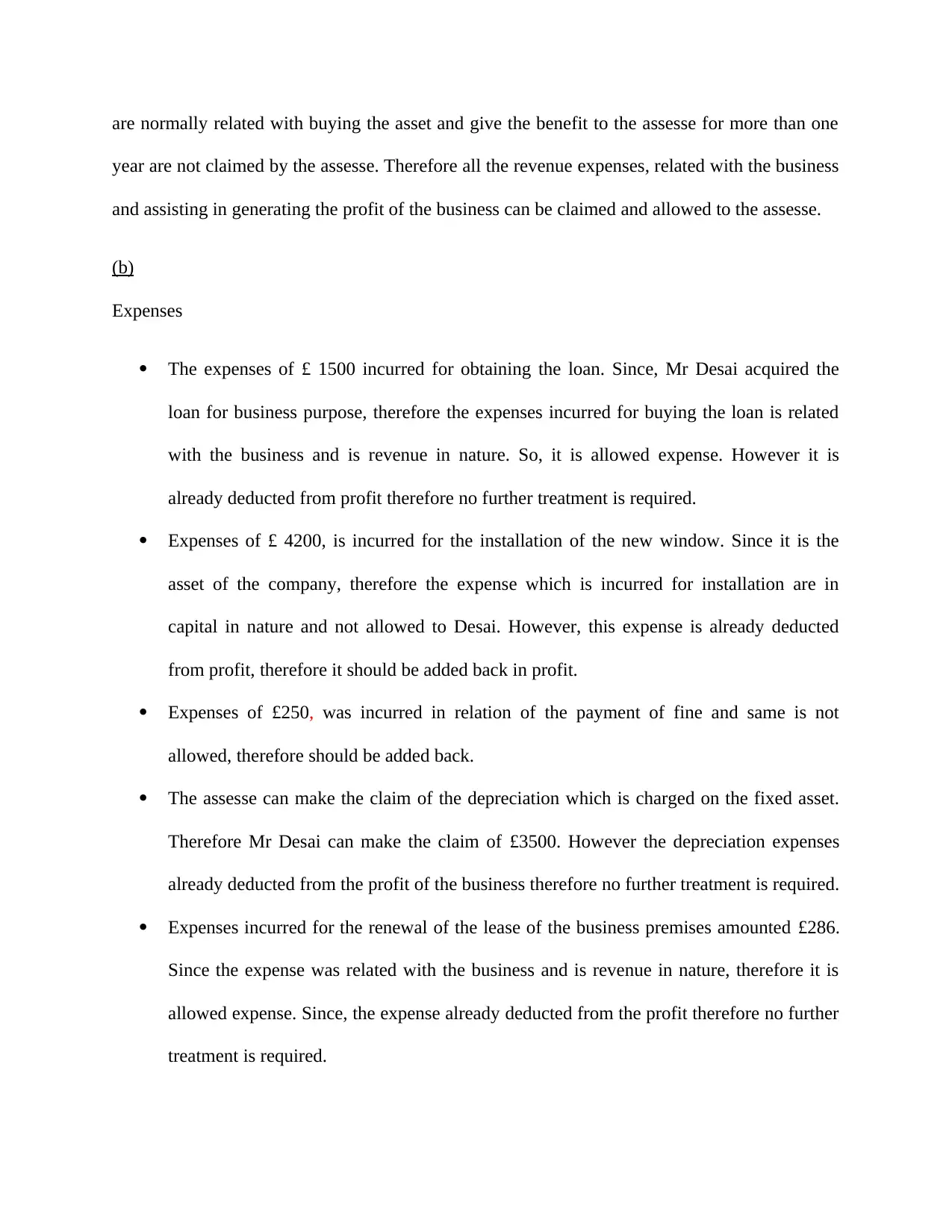
are normally related with buying the asset and give the benefit to the assesse for more than one
year are not claimed by the assesse. Therefore all the revenue expenses, related with the business
and assisting in generating the profit of the business can be claimed and allowed to the assesse.
(b)
Expenses
The expenses of £ 1500 incurred for obtaining the loan. Since, Mr Desai acquired the
loan for business purpose, therefore the expenses incurred for buying the loan is related
with the business and is revenue in nature. So, it is allowed expense. However it is
already deducted from profit therefore no further treatment is required.
Expenses of £ 4200, is incurred for the installation of the new window. Since it is the
asset of the company, therefore the expense which is incurred for installation are in
capital in nature and not allowed to Desai. However, this expense is already deducted
from profit, therefore it should be added back in profit.
Expenses of £250, was incurred in relation of the payment of fine and same is not
allowed, therefore should be added back.
The assesse can make the claim of the depreciation which is charged on the fixed asset.
Therefore Mr Desai can make the claim of £3500. However the depreciation expenses
already deducted from the profit of the business therefore no further treatment is required.
Expenses incurred for the renewal of the lease of the business premises amounted £286.
Since the expense was related with the business and is revenue in nature, therefore it is
allowed expense. Since, the expense already deducted from the profit therefore no further
treatment is required.
year are not claimed by the assesse. Therefore all the revenue expenses, related with the business
and assisting in generating the profit of the business can be claimed and allowed to the assesse.
(b)
Expenses
The expenses of £ 1500 incurred for obtaining the loan. Since, Mr Desai acquired the
loan for business purpose, therefore the expenses incurred for buying the loan is related
with the business and is revenue in nature. So, it is allowed expense. However it is
already deducted from profit therefore no further treatment is required.
Expenses of £ 4200, is incurred for the installation of the new window. Since it is the
asset of the company, therefore the expense which is incurred for installation are in
capital in nature and not allowed to Desai. However, this expense is already deducted
from profit, therefore it should be added back in profit.
Expenses of £250, was incurred in relation of the payment of fine and same is not
allowed, therefore should be added back.
The assesse can make the claim of the depreciation which is charged on the fixed asset.
Therefore Mr Desai can make the claim of £3500. However the depreciation expenses
already deducted from the profit of the business therefore no further treatment is required.
Expenses incurred for the renewal of the lease of the business premises amounted £286.
Since the expense was related with the business and is revenue in nature, therefore it is
allowed expense. Since, the expense already deducted from the profit therefore no further
treatment is required.
Paraphrase This Document
Need a fresh take? Get an instant paraphrase of this document with our AI Paraphraser

Income
Compensation received from the insurance company related with the damage of premised
amounted £18000 is not the profit from business activity therefore should be deducted
from trading profit.
Interest is received from the supplier in respect of the loan amount of £1000 is not trading
income so it will be deducted from profit.
(c)
Table 1: Calculation of the adjusting trading profit for the year ended December 2017
Particulars Amount (in £)
Net Profit for the year ended December 2017 12100
Less: income which is included in the income and expenditure
account and not related with the trading activity
Compensation received from insurances company (18000)
Interest earned on loan made to supplier (1000)
Add: expenses which are disallowed and should not be deducted
from income and expenditure account but already deducted
Expenses related with the installation of the window in factory 4200
Payment of the fine 250
Profit/loss from business (2450)
Compensation received from the insurance company related with the damage of premised
amounted £18000 is not the profit from business activity therefore should be deducted
from trading profit.
Interest is received from the supplier in respect of the loan amount of £1000 is not trading
income so it will be deducted from profit.
(c)
Table 1: Calculation of the adjusting trading profit for the year ended December 2017
Particulars Amount (in £)
Net Profit for the year ended December 2017 12100
Less: income which is included in the income and expenditure
account and not related with the trading activity
Compensation received from insurances company (18000)
Interest earned on loan made to supplier (1000)
Add: expenses which are disallowed and should not be deducted
from income and expenditure account but already deducted
Expenses related with the installation of the window in factory 4200
Payment of the fine 250
Profit/loss from business (2450)
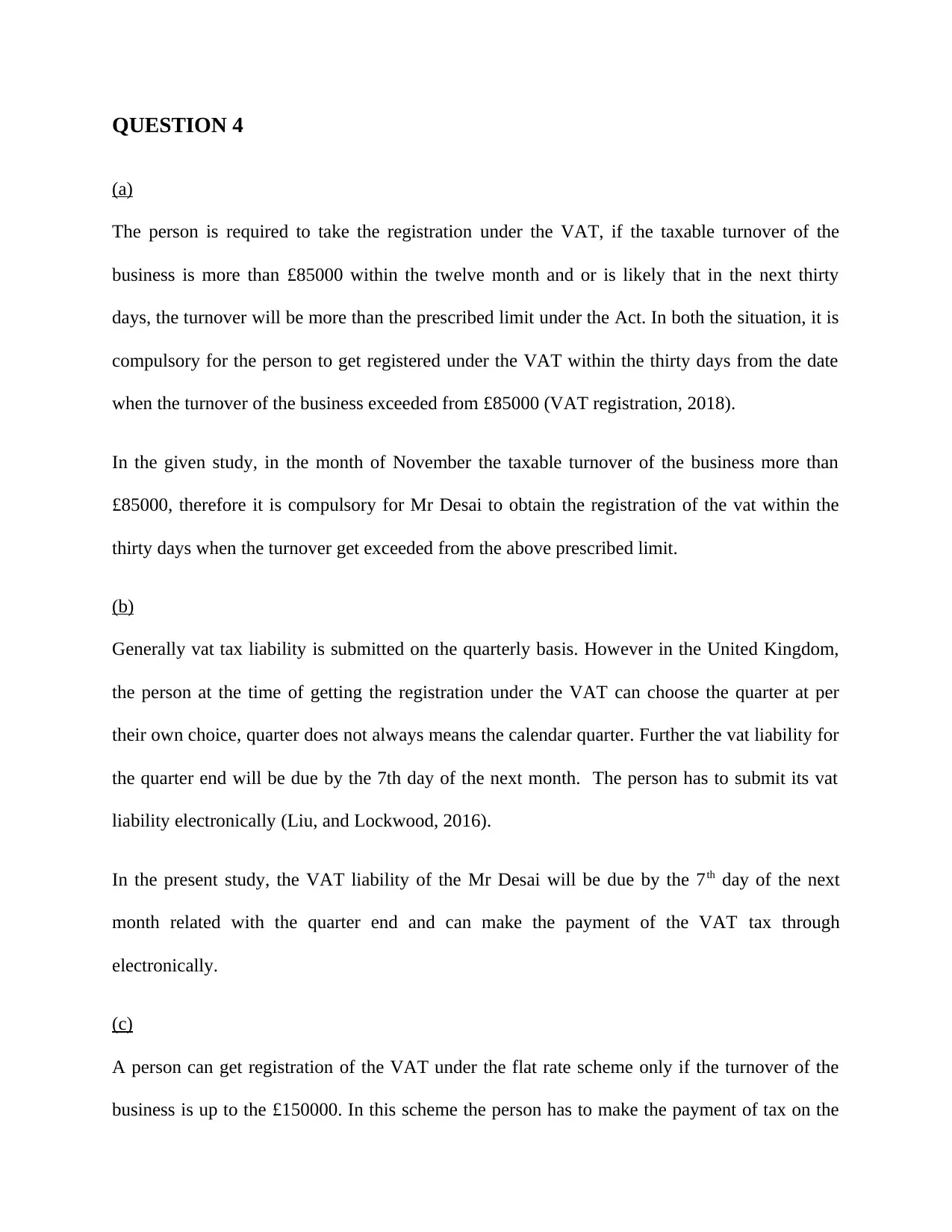
QUESTION 4
(a)
The person is required to take the registration under the VAT, if the taxable turnover of the
business is more than £85000 within the twelve month and or is likely that in the next thirty
days, the turnover will be more than the prescribed limit under the Act. In both the situation, it is
compulsory for the person to get registered under the VAT within the thirty days from the date
when the turnover of the business exceeded from £85000 (VAT registration, 2018).
In the given study, in the month of November the taxable turnover of the business more than
£85000, therefore it is compulsory for Mr Desai to obtain the registration of the vat within the
thirty days when the turnover get exceeded from the above prescribed limit.
(b)
Generally vat tax liability is submitted on the quarterly basis. However in the United Kingdom,
the person at the time of getting the registration under the VAT can choose the quarter at per
their own choice, quarter does not always means the calendar quarter. Further the vat liability for
the quarter end will be due by the 7th day of the next month. The person has to submit its vat
liability electronically (Liu, and Lockwood, 2016).
In the present study, the VAT liability of the Mr Desai will be due by the 7th day of the next
month related with the quarter end and can make the payment of the VAT tax through
electronically.
(c)
A person can get registration of the VAT under the flat rate scheme only if the turnover of the
business is up to the £150000. In this scheme the person has to make the payment of tax on the
(a)
The person is required to take the registration under the VAT, if the taxable turnover of the
business is more than £85000 within the twelve month and or is likely that in the next thirty
days, the turnover will be more than the prescribed limit under the Act. In both the situation, it is
compulsory for the person to get registered under the VAT within the thirty days from the date
when the turnover of the business exceeded from £85000 (VAT registration, 2018).
In the given study, in the month of November the taxable turnover of the business more than
£85000, therefore it is compulsory for Mr Desai to obtain the registration of the vat within the
thirty days when the turnover get exceeded from the above prescribed limit.
(b)
Generally vat tax liability is submitted on the quarterly basis. However in the United Kingdom,
the person at the time of getting the registration under the VAT can choose the quarter at per
their own choice, quarter does not always means the calendar quarter. Further the vat liability for
the quarter end will be due by the 7th day of the next month. The person has to submit its vat
liability electronically (Liu, and Lockwood, 2016).
In the present study, the VAT liability of the Mr Desai will be due by the 7th day of the next
month related with the quarter end and can make the payment of the VAT tax through
electronically.
(c)
A person can get registration of the VAT under the flat rate scheme only if the turnover of the
business is up to the £150000. In this scheme the person has to make the payment of tax on the
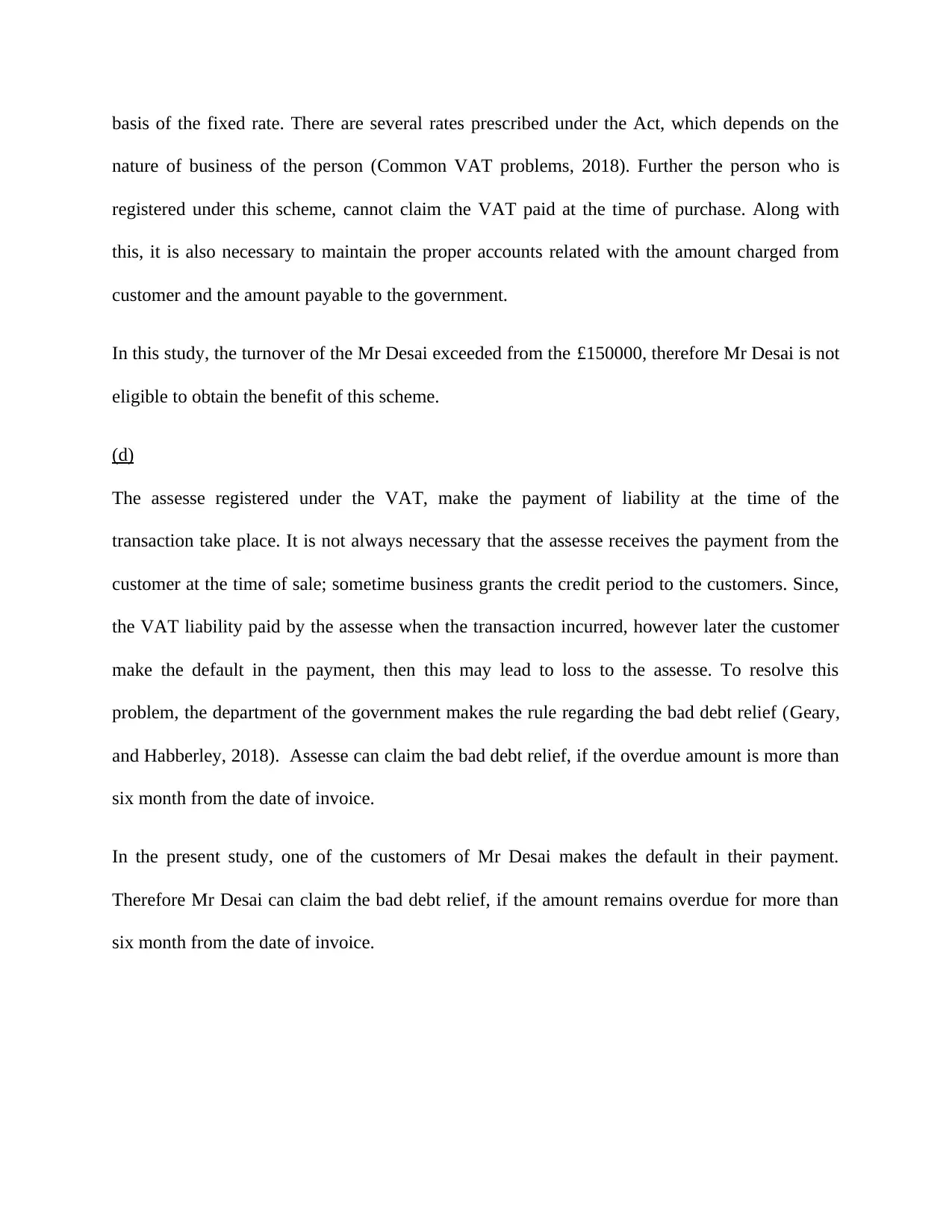
basis of the fixed rate. There are several rates prescribed under the Act, which depends on the
nature of business of the person (Common VAT problems, 2018). Further the person who is
registered under this scheme, cannot claim the VAT paid at the time of purchase. Along with
this, it is also necessary to maintain the proper accounts related with the amount charged from
customer and the amount payable to the government.
In this study, the turnover of the Mr Desai exceeded from the £150000, therefore Mr Desai is not
eligible to obtain the benefit of this scheme.
(d)
The assesse registered under the VAT, make the payment of liability at the time of the
transaction take place. It is not always necessary that the assesse receives the payment from the
customer at the time of sale; sometime business grants the credit period to the customers. Since,
the VAT liability paid by the assesse when the transaction incurred, however later the customer
make the default in the payment, then this may lead to loss to the assesse. To resolve this
problem, the department of the government makes the rule regarding the bad debt relief (Geary,
and Habberley, 2018). Assesse can claim the bad debt relief, if the overdue amount is more than
six month from the date of invoice.
In the present study, one of the customers of Mr Desai makes the default in their payment.
Therefore Mr Desai can claim the bad debt relief, if the amount remains overdue for more than
six month from the date of invoice.
nature of business of the person (Common VAT problems, 2018). Further the person who is
registered under this scheme, cannot claim the VAT paid at the time of purchase. Along with
this, it is also necessary to maintain the proper accounts related with the amount charged from
customer and the amount payable to the government.
In this study, the turnover of the Mr Desai exceeded from the £150000, therefore Mr Desai is not
eligible to obtain the benefit of this scheme.
(d)
The assesse registered under the VAT, make the payment of liability at the time of the
transaction take place. It is not always necessary that the assesse receives the payment from the
customer at the time of sale; sometime business grants the credit period to the customers. Since,
the VAT liability paid by the assesse when the transaction incurred, however later the customer
make the default in the payment, then this may lead to loss to the assesse. To resolve this
problem, the department of the government makes the rule regarding the bad debt relief (Geary,
and Habberley, 2018). Assesse can claim the bad debt relief, if the overdue amount is more than
six month from the date of invoice.
In the present study, one of the customers of Mr Desai makes the default in their payment.
Therefore Mr Desai can claim the bad debt relief, if the amount remains overdue for more than
six month from the date of invoice.
Secure Best Marks with AI Grader
Need help grading? Try our AI Grader for instant feedback on your assignments.
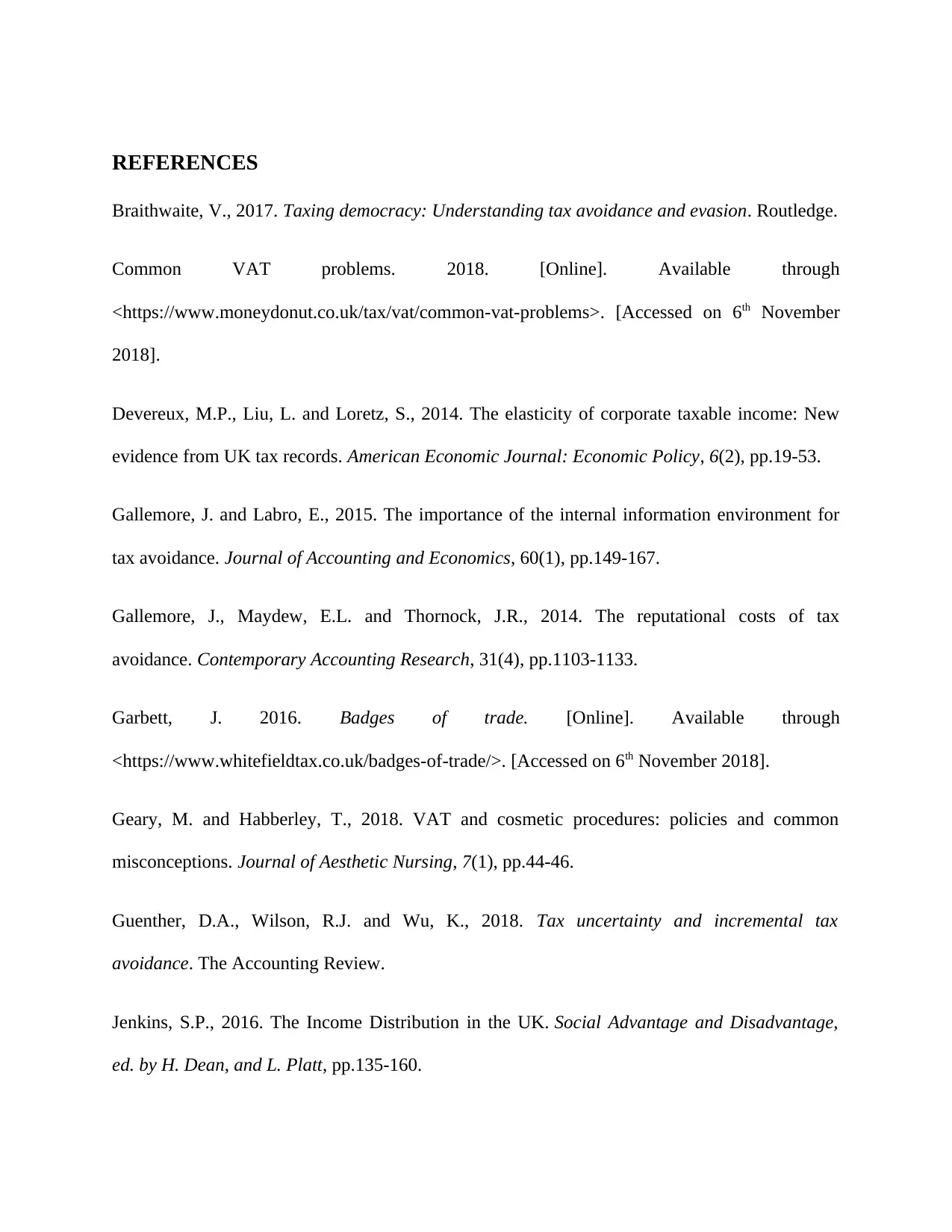
REFERENCES
Braithwaite, V., 2017. Taxing democracy: Understanding tax avoidance and evasion. Routledge.
Common VAT problems. 2018. [Online]. Available through
<https://www.moneydonut.co.uk/tax/vat/common-vat-problems>. [Accessed on 6th November
2018].
Devereux, M.P., Liu, L. and Loretz, S., 2014. The elasticity of corporate taxable income: New
evidence from UK tax records. American Economic Journal: Economic Policy, 6(2), pp.19-53.
Gallemore, J. and Labro, E., 2015. The importance of the internal information environment for
tax avoidance. Journal of Accounting and Economics, 60(1), pp.149-167.
Gallemore, J., Maydew, E.L. and Thornock, J.R., 2014. The reputational costs of tax
avoidance. Contemporary Accounting Research, 31(4), pp.1103-1133.
Garbett, J. 2016. Badges of trade. [Online]. Available through
<https://www.whitefieldtax.co.uk/badges-of-trade/>. [Accessed on 6th November 2018].
Geary, M. and Habberley, T., 2018. VAT and cosmetic procedures: policies and common
misconceptions. Journal of Aesthetic Nursing, 7(1), pp.44-46.
Guenther, D.A., Wilson, R.J. and Wu, K., 2018. Tax uncertainty and incremental tax
avoidance. The Accounting Review.
Jenkins, S.P., 2016. The Income Distribution in the UK. Social Advantage and Disadvantage,
ed. by H. Dean, and L. Platt, pp.135-160.
Braithwaite, V., 2017. Taxing democracy: Understanding tax avoidance and evasion. Routledge.
Common VAT problems. 2018. [Online]. Available through
<https://www.moneydonut.co.uk/tax/vat/common-vat-problems>. [Accessed on 6th November
2018].
Devereux, M.P., Liu, L. and Loretz, S., 2014. The elasticity of corporate taxable income: New
evidence from UK tax records. American Economic Journal: Economic Policy, 6(2), pp.19-53.
Gallemore, J. and Labro, E., 2015. The importance of the internal information environment for
tax avoidance. Journal of Accounting and Economics, 60(1), pp.149-167.
Gallemore, J., Maydew, E.L. and Thornock, J.R., 2014. The reputational costs of tax
avoidance. Contemporary Accounting Research, 31(4), pp.1103-1133.
Garbett, J. 2016. Badges of trade. [Online]. Available through
<https://www.whitefieldtax.co.uk/badges-of-trade/>. [Accessed on 6th November 2018].
Geary, M. and Habberley, T., 2018. VAT and cosmetic procedures: policies and common
misconceptions. Journal of Aesthetic Nursing, 7(1), pp.44-46.
Guenther, D.A., Wilson, R.J. and Wu, K., 2018. Tax uncertainty and incremental tax
avoidance. The Accounting Review.
Jenkins, S.P., 2016. The Income Distribution in the UK. Social Advantage and Disadvantage,
ed. by H. Dean, and L. Platt, pp.135-160.
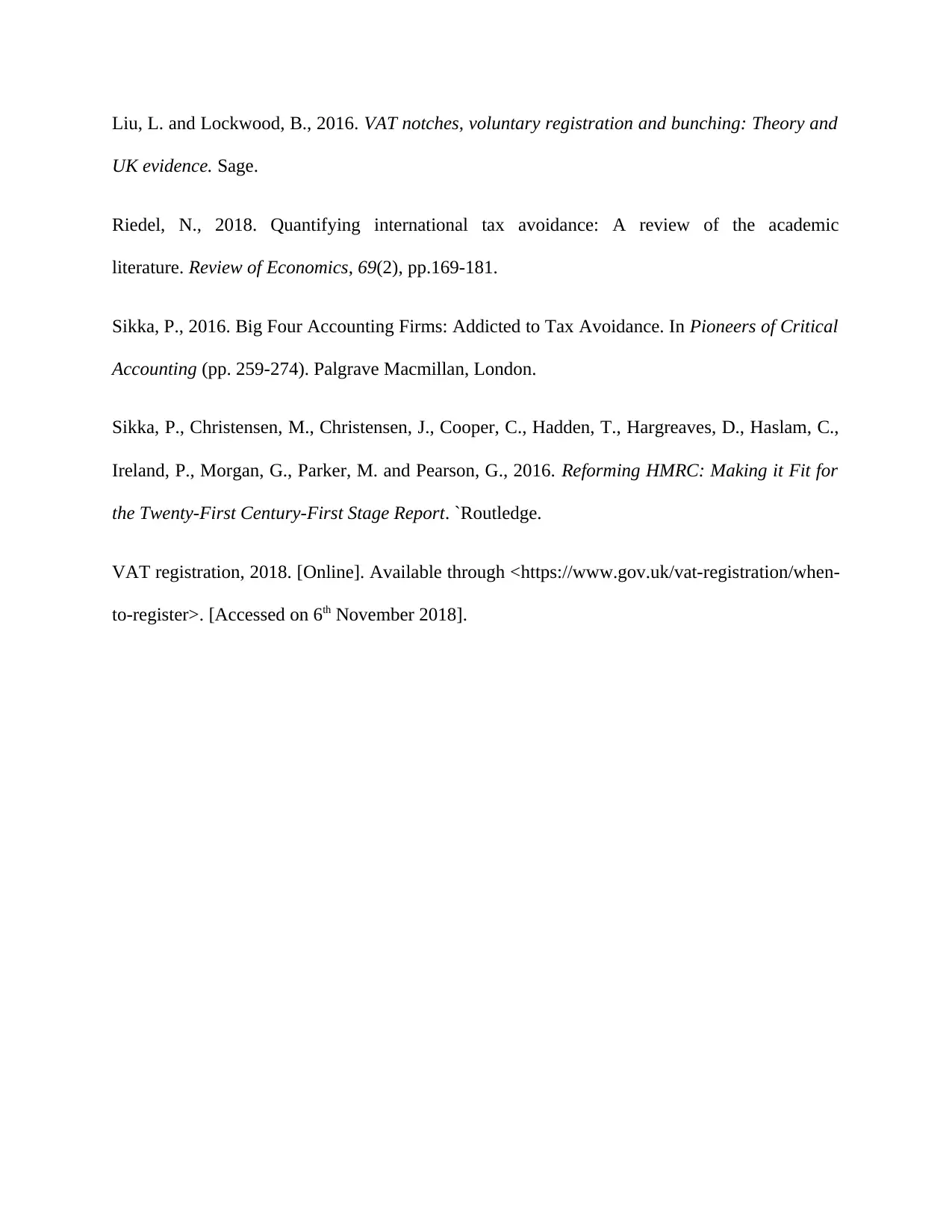
Liu, L. and Lockwood, B., 2016. VAT notches, voluntary registration and bunching: Theory and
UK evidence. Sage.
Riedel, N., 2018. Quantifying international tax avoidance: A review of the academic
literature. Review of Economics, 69(2), pp.169-181.
Sikka, P., 2016. Big Four Accounting Firms: Addicted to Tax Avoidance. In Pioneers of Critical
Accounting (pp. 259-274). Palgrave Macmillan, London.
Sikka, P., Christensen, M., Christensen, J., Cooper, C., Hadden, T., Hargreaves, D., Haslam, C.,
Ireland, P., Morgan, G., Parker, M. and Pearson, G., 2016. Reforming HMRC: Making it Fit for
the Twenty-First Century-First Stage Report. `Routledge.
VAT registration, 2018. [Online]. Available through <https://www.gov.uk/vat-registration/when-
to-register>. [Accessed on 6th November 2018].
UK evidence. Sage.
Riedel, N., 2018. Quantifying international tax avoidance: A review of the academic
literature. Review of Economics, 69(2), pp.169-181.
Sikka, P., 2016. Big Four Accounting Firms: Addicted to Tax Avoidance. In Pioneers of Critical
Accounting (pp. 259-274). Palgrave Macmillan, London.
Sikka, P., Christensen, M., Christensen, J., Cooper, C., Hadden, T., Hargreaves, D., Haslam, C.,
Ireland, P., Morgan, G., Parker, M. and Pearson, G., 2016. Reforming HMRC: Making it Fit for
the Twenty-First Century-First Stage Report. `Routledge.
VAT registration, 2018. [Online]. Available through <https://www.gov.uk/vat-registration/when-
to-register>. [Accessed on 6th November 2018].
1 out of 12
Related Documents
Your All-in-One AI-Powered Toolkit for Academic Success.
+13062052269
info@desklib.com
Available 24*7 on WhatsApp / Email
![[object Object]](/_next/static/media/star-bottom.7253800d.svg)
Unlock your academic potential
© 2024 | Zucol Services PVT LTD | All rights reserved.





